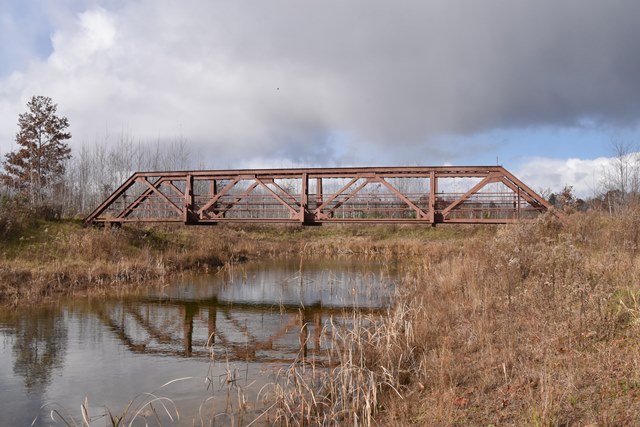We Recommend:
Bach Steel - Experts at historic truss bridge restoration.
BridgeHunter.com Phase 1 is released to the public! - Visit Now
Townhall Road Bridge
Beaverton School Forest Recreation Area Bridge

Primary Photographer(s): Nathan Holth
Bridge Documented: November 13, 2021
Rural: Gladwin County, Michigan: United States
1917 By Builder/Contractor: H. Stewart and Engineer/Design: Michigan State Highway Department
2018
65.0 Feet (19.8 Meters)
67.0 Feet (20.4 Meters)
Not Available
1 Main Span(s)
Not Applicable

View Information About HSR Ratings
Bridge Documentation
Relocated and reused for pedestrians in a recreation area, this is one of the few preserved truss bridges in northern lower Michigan. Prior to relocation, this bridge was unaltered, and had excellent historic integrity, despite deterioration of the floorbeams and lower chord connections. When the bridge was moved the trusses were narrowed, probably to reduce deck, new floorbeam, and abutment costs. The bridge was painted, but the lower chord section loss was not repaired prior to painting. However one remarkable change was made, and it is not known if it was on purpose or not: they put the trusses up backwards! You read that right, the trusses are BACKWARDS! This is one of the most unusual alterations ever encountered on a truss bridge! Another unfortunate outcome is that the beautiful riveted and original lattice railings were removed from the bridge. Perhaps if someone had left the attractive lattice railings in place on the bridge, then the contractor who erected the bridge would have figured out which way the trusses go! The reversal of the trusses may be the result of a contractor unfamiliar with the history of this very special bridge misinterpreting the design of this bridge. This bridge was one of the early Michigan State Highway Department standard plans for truss bridges. The design is detailed in historical literature linked to on this page. The unique design included interior knee bracing on the vertical members... in other words, the opposite of most pony truss bridges. Most pony truss bridges had outriggers, which was bracing that extended outside the truss lines. C. V. Dewart, who worked for the highway department felt that interior knee braces functioned better for lateral stability than outriggers, so he designed a bridge with interior knee bracing, which this bridge is an example of. It is possible that whoever reassembled this bridge thought the interior knee braces were outriggers.
View This Relocated Historic Bridge's Page In Its Previous Location Here
View Historical Articles About This Bridge's Standard Plan Design
![]()
Photo Galleries and Videos: Townhall Road Bridge
Bridge Photo-Documentation
Original / Full Size PhotosA collection of overview and detail photos. This gallery offers photos in the highest available resolution and file size in a touch-friendly popup viewer.
Alternatively, Browse Without Using Viewer
![]()
Bridge Photo-Documentation
Mobile Optimized PhotosA collection of overview and detail photos. This gallery features data-friendly, fast-loading photos in a touch-friendly popup viewer.
Alternatively, Browse Without Using Viewer
![]()
Maps and Links: Townhall Road Bridge
Coordinates (Latitude, Longitude):
Search For Additional Bridge Listings:
Bridgehunter.com: View listed bridges within 0.5 miles (0.8 kilometers) of this bridge.
Bridgehunter.com: View listed bridges within 10 miles (16 kilometers) of this bridge.
Additional Maps:
Google Streetview (If Available)
GeoHack (Additional Links and Coordinates)
Apple Maps (Via DuckDuckGo Search)
Apple Maps (Apple devices only)
Android: Open Location In Your Map or GPS App
Flickr Gallery (Find Nearby Photos)
Wikimedia Commons (Find Nearby Photos)
Directions Via Sygic For Android
Directions Via Sygic For iOS and Android Dolphin Browser
USGS National Map (United States Only)
Historical USGS Topo Maps (United States Only)
Historic Aerials (United States Only)
CalTopo Maps (United States Only)

